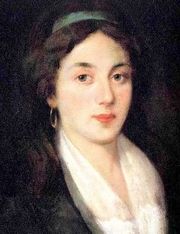
Éléonore Duplay
Encyclopedia

Cornelia Africana
Cornelia Scipionis Africana was the second daughter of Publius Cornelius Scipio Africanus, the hero of the Second Punic War, and Aemilia Paulla. She is remembered as the perfect example of a virtuous Roman woman....
of Ancient Rome, was the daughter of Maurice Duplay, a master carpenter, and Françoise-Éléonore Vaugeois. She was the eldest of five children (four girls and a boy) and was born in 1768, two years after her parents' marriage, in Paris
Paris
Paris is the capital and largest city in France, situated on the river Seine, in northern France, at the heart of the Île-de-France region...
, where she would live all her life. During the Revolution, she studied painting under Jean-Baptiste Regnault
Jean-Baptiste Regnault
Jean-Baptiste Regnault was a French painter.Regnault was born in Paris, and began life at sea in a merchant vessel. At the age of fifteen his talent attracted attention, and he was sent to Italy by M. de Monval under the care of Bardin...
.
According to her sister, Élisabeth, who married Philippe Le Bas
Philippe-François-Joseph Le Bas
Philippe-François-Joseph Le Bas was a French revolutionary.- Life :The son of a notary, intendant to the prince de Rache, avocat to the parliament of 1789, companion and collaborator of Saint-Just, in 1792 Le Bas was elected député to the National Convention for the Pas-de-Calais, sitting among...
of the Committee of General Security
Committee of General Security
The Committee of General Security was a French parliamentary committee which acted as police agency during the French Revolution that, along with the Committee of Public Safety, oversaw the Reign of Terror....
, she was "promised" to Maximilien Robespierre
Maximilien Robespierre
Maximilien François Marie Isidore de Robespierre is one of the best-known and most influential figures of the French Revolution. He largely dominated the Committee of Public Safety and was instrumental in the period of the Revolution commonly known as the Reign of Terror, which ended with his...
, whose political opinions she shared. He said of her, "âme virile, elle saurait mourir comme elle sait aimer" ("noble soul, she would know how to die as well as she knows how to love"). They often walked together in the Champs-Élysées
Champs-Élysées
The Avenue des Champs-Élysées is a prestigious avenue in Paris, France. With its cinemas, cafés, luxury specialty shops and clipped horse-chestnut trees, the Avenue des Champs-Élysées is one of the most famous streets and one of the most expensive strip of real estate in the world. The name is...
or the woods of Versailles
Versailles
Versailles , a city renowned for its château, the Palace of Versailles, was the de facto capital of the kingdom of France for over a century, from 1682 to 1789. It is now a wealthy suburb of Paris and remains an important administrative and judicial centre...
or Issy. Many contemporaries and historians have suggested that she may have been his mistress, including Vilate, a juror on the Revolutionary Tribunal
Revolutionary Tribunal
The Revolutionary Tribunal was a court which was instituted in Paris by the Convention during the French Revolution for the trial of political offenders, and eventually became one of the most powerful engines of the Reign of Terror....
, who said, that Robespierre "lived maritally with the eldest daughter of his hosts," in reference to Éléonore. After his death she wore black for the rest of her life, never marrying, and was known as la Veuve Robespierre (the Widow Robespierre).
Though guilty of no crime, she was imprisoned with her sister Élisabeth and her six week-old nephew, Philippe Le Bas fils
Philippe Le Bas
Philippe Le Bas was a French hellenist, archaeologist and translator. He was the son of Philippe Le Bas and Elisabeth Duplay, the daughter of Robespierre's landlord Maurice Duplay. He was only 6 weeks old when his father committed suicide on Robespierre's fall on 27 July 1794 in the Thermidorian...
after 9 Thermidor. Élisabeth would later write in her memoir, "Oh! Je ne t'oublierai pas de ma vie! Car sans toi j'aurais succombé; mais par ton courage, tu as ranimé mes forces et tu m'a appris que j'avais une grande tâche à remplir que j'avais un fils, qu'il fallait vivre pour lui" and elsewhere, "non, bonne chère soeur Éléonore, je n'oublierai de ma vie tout ton dévouement pour moi et pour ton pauvre petit neveu; ma reconnaissance sera éternelle!" (Roughly translated: "Oh! I will not forget you in my lifetime! For without you I would have succumbed; but by your courage, you reanimated my force and taught me that I had a great task to fulfill in that I had a son and it was necessary to live for him" and "no, good, dear sister Éléonore, I will not forget in my lifetime all your devotion for me and for your poor little nephew!") They would not be released until 18 Frimaire Year III.
Éléonore Duplay died on 26 July 1832, at the age of sixty-four, and was buried in the cemetery of Père Lachaise, where her grave may still be seen in the 34th division.

